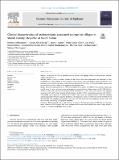Clinical Characteristics of Onchocerciasis-associated Epilepsy in Villages in Maridi County, Republic of South Sudan
View/
Publication Date
2018-11Type
Article, Journalviews
downloads
Metadata
Show full item recordCitation
Colebunders R, Abd-Elfarag G, Carter JY, Olore PC, Puok K, Menon S, Fodjo Siewe JN, Bhattacharyya S, Ojok M, Lako R, Logora MY. Clinical characteristics of onchocerciasis-associated epilepsy in villages in Maridi County, Republic of South Sudan. Seizure. 2018 Nov;62:108-115. doi: 10.1016/j.seizure.2018.10.004. Epub 2018 Oct 5. PMID: 30340162.
Abstract/
C T Purpose: To describe the clinical manifestations of persons with epilepsy (PWE) in onchocerciasis endemic villages in South Sudan. Methods: During a survey in Maridi County in May 2018, PWE were interviewed and examined in their households by a clinical o cer or medical doctor. Onchocerciasis-associated epilepsy (OAE) was de ned as 2 seizures without any obvious cause, starting between the ages of 3–18 years in previously healthy persons who had resided for at least 3 years in the onchocerciasis endemic area. Results: Seven hundred and thirty-six PWE were included in the study; 315 (42.8%) were females; median age was 18 years. A variety of seizure types were reported: generalized tonic-clonic seizures in 511 PWE (69.4%), absences in 15 (2.0%), focal motor seizures with full awareness in 7 (1.0%), focal motor seizures with impaired awareness in 25 (3.4%), brief episodes of hallucinations in 316 (43.9%) and nodding seizures in 335 (45.5%). The median age of onset of all seizures was 10 years, and 8 years for nodding seizures. PWE with nodding seizures presented with more cognitive disabilities. The diagnostic criteria for OAE were met by 414 (85.2%) of the 486 PWE with complete information. Eighty (11.0%) PWE presented with Nakalanga features. Only 378 (51.4%) PWE were taking anti-epileptic treatment. Conclusion: PWE presented with a wide spectrum of seizures. The high percentage of PWE who met the diagnostic criteria for OAE suggests that better onchocerciasis control could prevent new cases. Urgent action is needed to
Subject/
Onchocerciasis; Epilepsy; Nodding syndrome; Nakalanga syndrome; Ivermectin; Treatment; Maridi; South Sudan
Further Details
© 2018 The Authors. Published by Elsevier Ltd on behalf of British Epilepsy Association. This is an open access article under the CC BY-NC-ND license (http://creativecommons.org/licenses/BY-NC-ND/4.0/).
Publisher
ElsevierCollections
- General - GEN [367]

